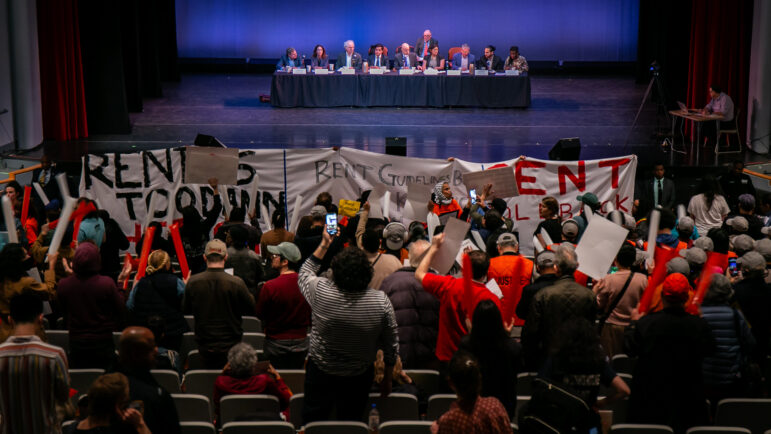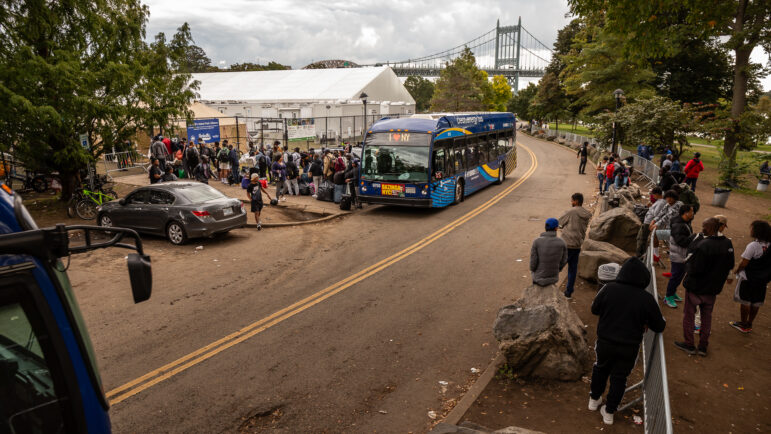
Jeanmarie Evelly
While the pandemic has disturbed our sense of time, a look at the calendar confirms that it’s been a little more than two months since the NYPD shoved and beat protesters who held the first local demonstration against the death of George Floyd. After that Thursday, May 28th, protests spread to other boroughs, even with stay-at-home orders still in place. The turn to other neighborhoods gave the protests an impressive turnout and liveliness. Protesters defied the early June curfew, and demonstrations keep going across town to this day. Under extreme perseverance, a City Hall occupation was organized in late June to demand changes in the new fiscal year budget.
Despite the impressive mobilization, the protesters’ central demand—to cut at least $1 billion from the NYPD’s budget—was not met, although Mayor Bill de Blasio and Council Speaker Corey Johnson insist on claiming otherwise. The failure to achieve that central demand may lead to discouragement or dismissal of protests and grassroots activity, especially for those witnessing the demonstrations from the outside, or newbies to social movement work. But as a social movement scholar, I can say that such a setback doesn’t invalidate the fact that meaningful social change only happens from the bottom up. To those who may feel some protest blues, don’t forget that social change also requires planning.
The recent protests under the banner of Black lives matter set participation records in the U.S., and a unique demand—to defund the police—quickly emerged, and has been particularly strong in big cities. While de Blasio and Governor Andrew Cuomo have bragged about the state and city’s move toward more police accountability to discourage the conversation on defunding police departments, similar police reforms elsewhere have proved toothless. For example, around five years ago, one city diligently adopted the Obama-era reform playbook following some high-profile police killings, including Jamar Clark’s in 2015 and Philando Castile’s in 2016. That city is Minneapolis, where Mr. Floyd was killed.
Police reforms will not meet the promises of hindering racial disparities, because police departments’ consistent display of excessive force and racial bias are symptoms of the hierarchies entrenched in our society. Given that policing is about social control, the allocation of a disproportionate sum of dollars to police departments across the country—in comparison to other services—isn’t an accident. But police reforms that don’t get to the roots of the problem need not be accepted under the excuse that the case to defund is too radical. A strategic approach—one that considers bumps on the road and has an eye toward the future—is crucial to those who, from the streets, seek to dismantle a fundamental pillar in the oppression of people of color.
 CityViews are readers’ opinions, not those of City Limits. Add your voice today!
CityViews are readers’ opinions, not those of City Limits. Add your voice today!
Protests can switch the balance of forces in society, especially when they are massive and sustained over time. Because grievances become public, the issue at stake must be faced by ordinary people and those in power. This last wave of rallies, marches, vigils, monument removal, etc. has consumed organizers’ blood, sweat, and tears, and has galvanized enormous nationwide support beyond the streets, with a shift in the conversation about racial equality and policing. But protests and movements don’t happen in a void, and inevitably, the tactic of relying on the streets to disrupt the normal pace of life gets exhausted. Two months after the first demonstration, the window of opportunity for further changes in the police department, as an institution, has momentarily closed. The brutal eviction of the City Hall occupation and the deployment of federal agents to certain cities attest to that.
Still, that the demand to defund has gotten such momentum and that the outcry over Floyd’s death has been associated with longstanding concerns about the treatment of Black people indicates a decisive step toward substantial change. With that, the temporary closing of a window calls for recalibration for another breakthrough, following the shift initiated in the streets two months ago. The path to transformation is non-linear, and those engaged in the fight to recast the current public safety paradigm should expect that their cause may move forward while also receiving some pushback.
Some may assume that a turn to electing progressive candidates of color to office is indispensable in the aftermath of the protests. While the last years have shown the relevance of legal, institutional actions to counter reactionary offenses, positive changes result from movements’ influence no matter who’s in power. Strong progressive movements are what we need first and foremost to guarantee that demands become reality. Following the protests’ peak, it’s crucial to leverage the current openness to discuss race and racism and foster regular participation in movement activities and work. The connections built over the last months should be nourished to optimize such initiatives. Fomenting spaces of restorative justice allows us to imagine and experience communities under a new safety model. Broader alliances between African-American communities and immigrant communities can guarantee that an agenda centered on fighting racial oppression doesn’t get sidelined amid election talks.
The current campaigns for rent cancellation across the city, efforts to immediately release detainees threatened by COVID-19, and initiatives to organize Black workers point in the right direction for highlighting the structural racism deep-rooted in our society. But predicting when there will be another window for radical changes in policing—the capstone of an antiracist agenda—is impossible. A few months ago, no one could say that the country would see its greatest uprising since the 1960s and, yet, it happened. Social upheavals—and not only pandemics—can disorient our sense of time. Some weeks may suddenly feel like an entire decade of transformation. To get to a police-free society, it is imperative to be prepared for when these hectic weeks return.
Nara Roberta Silva is an Associate Faculty Member at the Brooklyn Institute for Social Research.









One thought on “Opinion: BLM Protests Are Pivotal in Fight for Racial Justice, Despite NYPD Defunding Fumble”
Excellent piece. I would add that the direct actions physically blocking landlords from appearing in court for evictions or from removing/intimidating tenants are an excellent tactic, as would be shutting down ICE transportation services and other targeted protests.
The other side of this coin is to form our own groups, that we then develop into institutions, to replace the ones that harm us. What does community-run public safety look like to you?
Electing progressives may soften the pain a bit, but we can’t rely on any elected official to abolish the police for us. Don’t just ask for change, organize and create change.